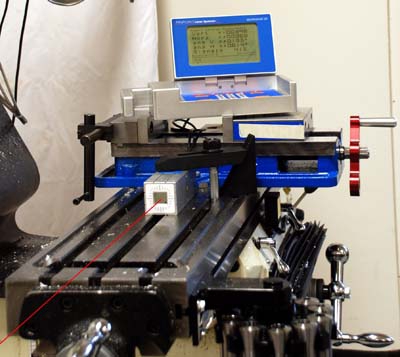
Pinpoint Laser Systems is announcing a new four axis Microgage Receiver that provides useful alignment information for evaluating and correcting machinery alignment problems. The new 4D Microgage Receiver measures two linear axes X and Y and their two angular components yaw and pitch. The two linear axes show how well machinery is aligned along a common centerline and the angular readouts show if parallelism problems are present. The new 4D Microgage Receiver is ideal for aligning lathes, turning centers, spindles as well as moving linear slides, rams and pistons, injection molding machinery, moving mechanical subassemblies and more. A compact, digital display provides precise linear and angular readings and is easy and intuitive to use.
The method of operation is simple — a narrow laser beam provides a measuring reference line and the 4D Microgage Receiver measures where this laser line lands on an internal detector and determines the position of a machine or sub-assembly relative to this laser reference beam. This receiver will operate over distances of 100 feet or more and deliver a measuring precision of 0.0005 inch and 0.002 degrees; ideal for demanding industrial alignment applications. The Laser Microgage system along with this new 4D Microgage Receiver puts precise measuring and alignment capability right into the hands of plant engineers and manufacturing personnel so that they can monitor and optimize their own production machinery and equipment.
Contact Details
Related Glossary Terms
- centers
centers
Cone-shaped pins that support a workpiece by one or two ends during machining. The centers fit into holes drilled in the workpiece ends. Centers that turn with the workpiece are called “live” centers; those that do not are called “dead” centers.
- pitch
pitch
1. On a saw blade, the number of teeth per inch. 2. In threading, the number of threads per inch.
- turning
turning
Workpiece is held in a chuck, mounted on a face plate or secured between centers and rotated while a cutting tool, normally a single-point tool, is fed into it along its periphery or across its end or face. Takes the form of straight turning (cutting along the periphery of the workpiece); taper turning (creating a taper); step turning (turning different-size diameters on the same work); chamfering (beveling an edge or shoulder); facing (cutting on an end); turning threads (usually external but can be internal); roughing (high-volume metal removal); and finishing (final light cuts). Performed on lathes, turning centers, chucking machines, automatic screw machines and similar machines.







